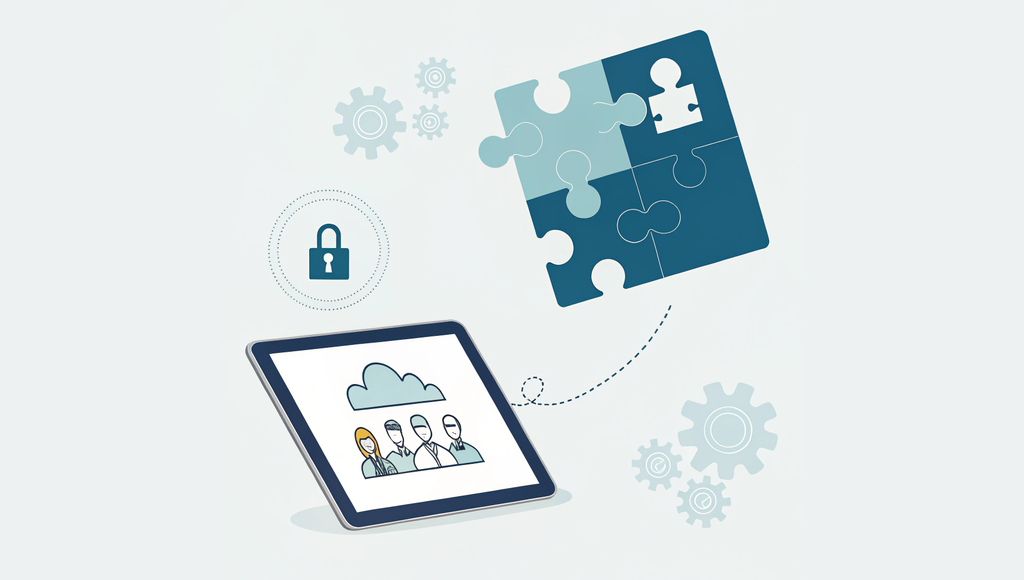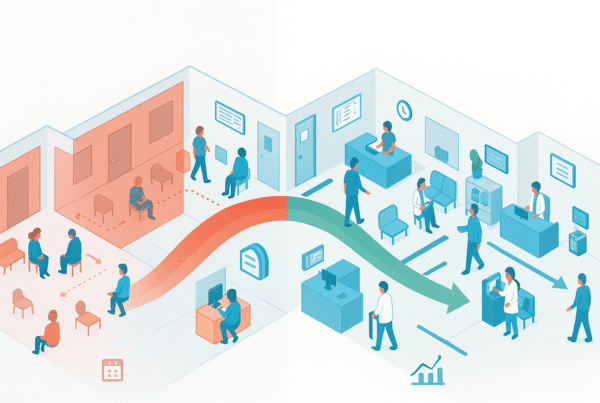
After months of negotiation, due diligence, and legal reviews, the deal to sell your practice is finally signed. While this marks a major financial and professional milestone, one of the most operationally complex phases is just beginning. As we cover in our guide to post-acquisition changes, technology and Electronic Medical Record (EMR) integration often prove to be the most disruptive and underestimated hurdle.
For you and your staff, this isn’t an abstract business problem. It’s a direct challenge to the daily workflows that ensure quality patient care. An ill-planned tech transition can lead to data loss, frustrated staff, and a dip in productivity that sours the post-sale experience.
This guide provides a clear-eyed look at the most common technology integration challenges you will likely face. More important, it offers a proactive roadmap to help you anticipate these issues and prepare for a smoother transition.
Why Tech Integration Is a Top M&A Risk
In today’s healthcare M&A landscape, technology is no longer a secondary consideration. It is a primary factor that can make or break a deal’s success. The financial and operational stakes are incredibly high.
Recent industry analyses reveal a sobering reality:
Over 40% of failed or delayed healthcare M&A deals cite post-merger technology integration as a primary cause.
Acquirers have taken notice. According to reports from Kaufman Hall, a buyer’s evaluation of a practice’s IT compatibility and digital integration potential can now account for up to 30% of the total deal evaluation criteria. This focus shows that buyers understand a poor tech fit will lead to significant unforeseen costs and operational drag. For you as a seller, this means the state of your technology and your readiness for integration directly impact your practice’s attractiveness and final valuation.
The Core Technology & EMR Integration Challenges
The term “technology integration” covers a range of distinct but related problems. When your practice is acquired, you will almost certainly encounter one or more of the following five challenges.
1. Disparate Systems and Lack of Interoperability
True interoperability is the ability of different technology systems to access, exchange, and use data effectively. Unfortunately, it is rarely achieved without significant effort. Your practice likely uses a mix of software for its EMR, billing, scheduling, and patient portals. The buyer has their own, often entirely different, set of systems.
This creates several points of friction:
– Incompatible Platforms: Your EMR may be from a different vendor than the buyer’s, with no native ability to communicate.
– Data Silos: Patient information becomes trapped in separate systems, increasing the risk of errors, duplicate tests, and poorly coordinated care.
– Workflow Chaos: Staff may need to use multiple logins or manually transfer data between old and new systems, a process that is both inefficient and prone to error.
This isn’t just an IT project; it’s a fundamental shift in daily work, impacting all the operational changes that follow an acquisition.
2. Hidden Costs and Budget Overruns
The promise of operational synergies often drives an acquisition, but buyers and sellers alike frequently underestimate the true cost of integrating technology. The expense goes far beyond new software licenses.
Be prepared for potential budget items that include:
– Fees for specialized data migration consultants to extract and transfer records.
– The cost of new hardware or network infrastructure required to run the buyer’s systems.
– Investments in custom development to build “bridges” between incompatible systems.
– Significant lost productivity as your team spends weeks in training and adjusts to less familiar workflows.
These costs can escalate quickly, eroding the financial upside that made the deal attractive in the first place.
3. Data Security and HIPAA Compliance
During an M&A transaction, you are moving your single most valuable and sensitive asset: your patient data. Transferring years of Protected Health Information (PHI) from one system to another creates a period of heightened vulnerability. A single mistake can lead to a significant data breach, resulting in massive HIPAA fines, legal liability, and irreparable damage to your professional reputation.
The process demands rigorous security protocols, data encryption, and multiple audits to ensure no information is lost or exposed. Managing this requires deep expertise, often from specialized IT and compliance consultants who understand the unique risks of healthcare data migration.
4. The Human Factor: Staff Resistance and Adoption
Your clinical and administrative staff have spent years mastering your current EMR and related software. Their workflows are built around its specific functions and quirks. Introducing a new system disrupts that hard-won expertise and can be met with significant resistance.
Physicians and staff may feel the new EMR is less intuitive, slower, or poorly suited to their specialty. This isn’t just a matter of preference; it’s a real barrier to adoption that can slow down patient encounters and hurt morale. Without a thoughtful change management plan that includes clear communication and comprehensive training, you risk a prolonged period of frustration and inefficiency.
5. Lack of Industry Standardization
Unlike other industries, healthcare lacks universal data standards. This means that data created in one EMR system is often structured completely differently from data in another. Migrating records is not a simple “copy and paste” operation. It requires a complex mapping process to ensure, for example, that a blood pressure reading from your old system ends up in the correct field in the new one. This challenge is magnified in healthcare roll-up strategies, where a buyer attempts to integrate dozens of different systems into one standardized platform.
A Proactive Roadmap for a Smoother Tech Transition
While these challenges are significant, they are not insurmountable. Proactive planning and asking the right questions during the M&A process can mitigate most of these risks. Use the following checklist to guide your preparation.
| Action Item | Why It Matters | Key Question to Ask a Potential Buyer |
|---|---|---|
| Prioritize IT in Early Due Diligence | Identifies potential deal-breakers upfront and prevents last-minute surprises. This is a crucial part of any modern financial due diligence review. | “Can you provide a detailed audit of your technology stack and how it compares to ours?” |
| Scrutinize the Buyer’s Integration Plan | A vague plan is a red flag. A good partner will have a clear, documented process for data migration, training, and support. | “What is your specific timeline for EMR integration, and what resources will you provide for staff training?” |
| Plan and Budget for Change Management | Acknowledges that staff adoption is critical. Treating training as a core cost ensures it gets the attention it deserves. | “How do you handle staff who are resistant to change, and what is your process for gathering feedback post-implementation?” |
| Discuss a Phased Integration | A “big bang” switch can be incredibly disruptive. A staged rollout can reduce the initial shock and allow for troubleshooting. | “Would you consider running our current system in parallel for a short period to ensure a smooth transition?” |
Position Your Practice for a Successful Transition
Technology integration is arguably the most complex operational aspect of any healthcare M&A deal. The risks—from data breaches and cost overruns to frustrated staff—are real. Success depends on shifting your mindset from viewing technology as a post-close problem to treating it as a core part of the transaction itself.
By performing thorough due diligence and demanding a clear integration plan from your buyer, you can protect your staff, your patients, and the long-term value of the practice you’ve worked so hard to build.
At SovDoc, we help you evaluate a buyer’s technological capabilities and integration plan as a key part of our advisory process. If you are preparing for a sale, contact us to see how we can help you position your practice for a successful transition, not just a successful transaction.
Frequently Asked Questions
What are the biggest technology problems after selling my medical practice?
The biggest technology problems include disparate systems lacking interoperability, hidden costs and budget overruns, risks related to data security and HIPAA compliance, staff resistance to new EMR systems, and the lack of industry standardization that complicates data migration.
How long does it typically take to merge EMR/EHR systems after a practice sale?
The timeline for merging EMR/EHR systems depends on the complexity of integration, interoperability challenges, and the buyer’s technology plan. A phased integration approach, discussed early with the buyer, can help manage disruptions and generally prevents a prolonged immediate switchover.
Will my staff be able to adapt to a new EMR system without disrupting patient care?
Staff adaptation can be challenging as the new EMR may differ significantly from what they are used to, resulting in resistance and possible workflow disruptions. A structured change management plan including clear communication and robust training is essential to minimize impact on patient care.
How can sensitive patient data be protected during the technology transfer post-acquisition?
Protecting patient data requires rigorous security protocols like data encryption, thorough audits before and during migration, and working with specialized IT and compliance consultants to ensure HIPAA compliance and prevent data breaches.
What are the hidden costs of EMR integration that sellers should be aware of?
Hidden costs often include fees for data migration consultants, new hardware or infrastructure expenses, custom development for system compatibility, and lost productivity costs due to staff training and workflow adjustment periods.



